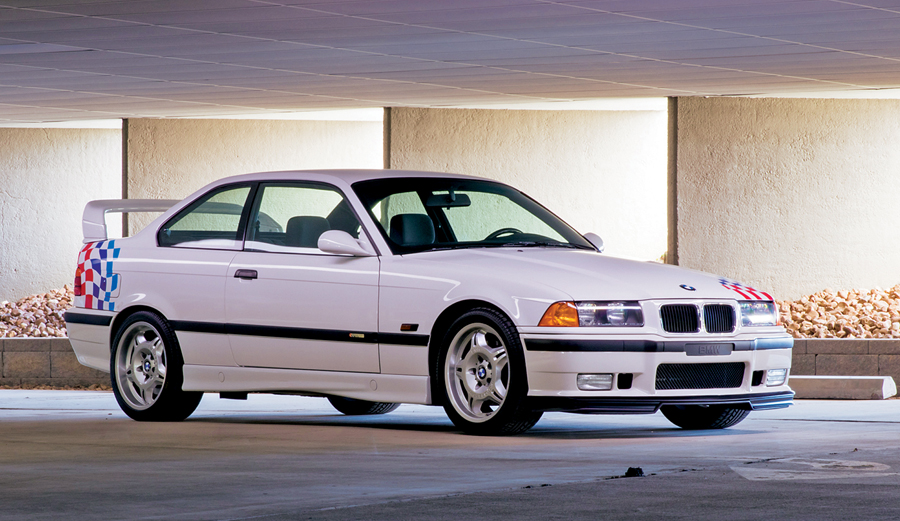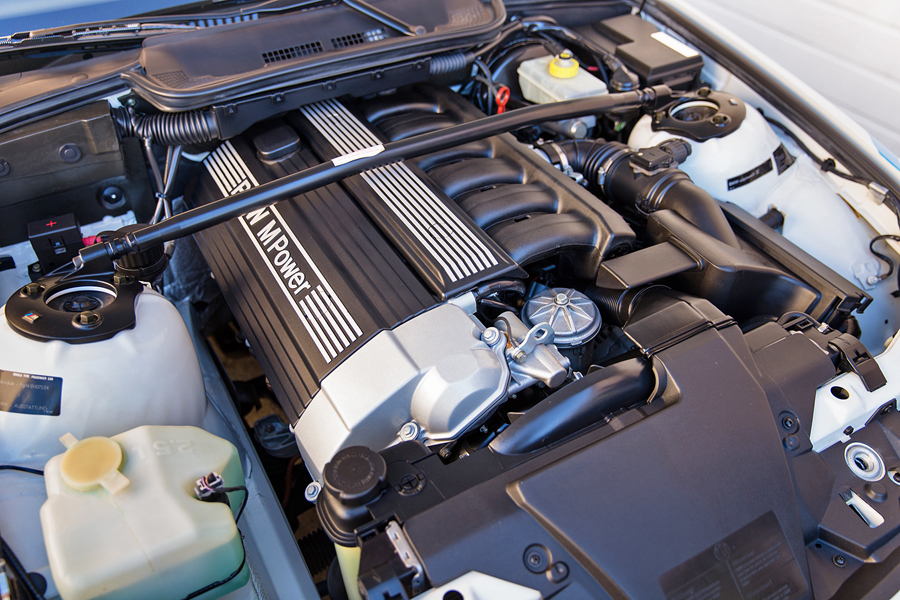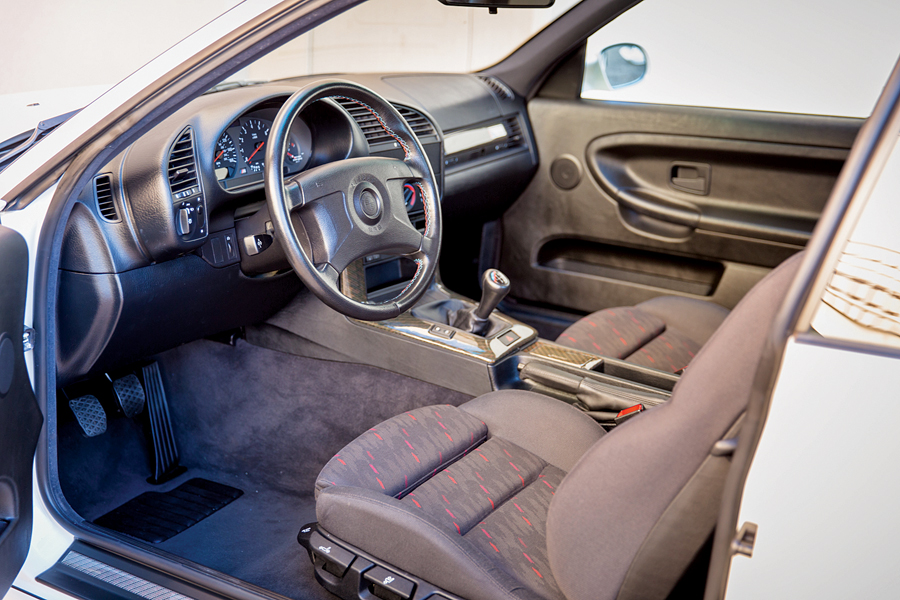SCM Analysis
Detailing
| Vehicle: | 1995 BMW M3 lightweight coupe |
| Years Produced: | 1995 |
| Number Produced: | 126 |
| Original List Price: | $47,470 |
| SCM Valuation: | $71,500 |
| Tune Up Cost: | $750 |
| Chassis Number Location: | On the dashboard near the lower left windshield, on the end of the left front door and on the gear housing |
| Engine Number Location: | Under the inlet manifold |
| Club Info: | BMW Car Club of America |
| Website: | http://www.bmwccca.org |
| Alternatives: | 1996–97 Porsche 993 Twin Turbo, 1994 BMW M3-R, 1994 BMW M3 GTR |
| Investment Grade: | B |
This car, Lot 28, sold for $145,750, including buyer’s premium, at Gooding & Company’s 2017 Amelia Island Auction on March 10, 2017.
The M3 Lightweight is referred to in BMW alphanumeric code parlance as the E36 M3 Lightweight CSL. The car is a special track-oriented homologation version of the U.S.-specification 1995 E36 M3 coupe. The M3 Lightweight was conceived of as a model for serious track-driving enthusiasts. In January 1995, BMW’s Motorsport Brand Manager Erik Wensberg wrote the following description in a dealer sales bulletin:
“1995 BMW M3 Lightweight: Designed for the performance purist and/or active competitor, the M3 Lightweight is a limited-production specialty product built with competition in mind. This road-legal model will be produced to special standards, deleting all unnecessary comfort and convenience equipment, and adding a number of performance upgrades which are all based on the European M3 GT homologation series for worldwide GT racing. The M3 Lightweight defines the true essence of the M3 performance profile.”
Like many specialty-built performance cars of the era, the M3 Lightweight was not an immediate sales hit for BMW dealers. However, BMW was certainly ahead of their time given the recent surge in popularity of the “Enthusiast Production Models.”
A bare-bones racing BMW
The M3 Lightweight had several special features that increased performance and decreased weight.
BMW engineers shortened the final drive to a 3.23:1 ratio but left the stock M3 engine alone. Aluminum doors were added and air conditioning was removed to cut weight. Other Weight Watchers enhancements included reducing sound insulation, removing the radio and leaving the toolkit behind.
Power leather seats were replaced with manually operated cloth versions. A beefier front spoiler and an optional larger rear wing gave the M3 Lightweight a subtle — yet aggressive — look. The front left and right rear were treated with artistic BMW Motorsport-colored checkered flags.
The M3 Lightweight also received a liberal application of additional special-edition motorsport emblems. The dashboard and console got a layer of carbon-fiber coverings to further distinguish the M3 Lightweight from its stock M3 siblings. When all was said and done, the M3 Lightweight lost 225 pounds and tipped the scales at 2,950 pounds.
A rare racer
Because only 126 E36 M3 Lightweights were produced, this special homologation edition deserves legitimate rarity status. But low production is not the only reason why the M3 Lightweight is a significant and desirable collector car for the rabid BMW M enthusiast.
This model checks three crucial boxes:
- It’s rare.
- It’s got significant race history.
- It was manufactured for one year.
The 1995 24 Hours of Daytona marked the beginning of the IMSA GTS-2 season, and it also marked the launch of BMW’s all-new GTS-2 M3 program. The E36 M3 enjoyed a very successful racing career from 1995 to 1998. Over the E36’s lifespan, BMW’s Prototype Technology Group continuously improved the M3. This quintessentially German evolutionary process helped the E36 become a serious contender on the track. Over a four-year period, the E36 M3 enjoyed lots of podium finishes. In 1997, the Number 10 PTG M3 with Bill Auberlen behind the wheel won the 24 Hours of Daytona.
A riser in the treaty-sale market
While researching the M3 Lightweight, I consulted with Eric Keller, co-founder of Ohio-based Enthusiast Auto Group, which specializes in rare and classic BMW M cars.
EAG has sourced, sorted and sold dozens of E36 M3 Lightweight CSLs over the past 17 years.
Keller said Lightweight prices have risen from $25,000 in the mid-2000s all the way to six figures today. EAG’s high-water-mark sale of an M3 Lightweight took place in April 2015, when an extremely well-preserved example sold for $200,000.
This particular car had 125 delivery miles and was only on the market for a few weeks. During the past six months, EAG has sold three M3 Lightweights with mileage ranging from 12,000 to 21,000 miles. EAG sold these three cars for $115,000 to $135,000.
A market-correct sale
Our subject car had only 7,500 original miles on the clock. This particular M3 had only two prior long-term owners.
The all-in auction price of $145,750 appears to be in line with the current market.
Given Keller’s commentary on recent private-market transactions, this sale appears to be a fair deal — given the low mileage and ownership provenance.
The bigger question is the future appreciation potential of the M3 Lightweight. Keller estimates that more than half of these cars were on the track. He said most of the remaining M3 Lightweights are high-mileage cars that were driven hard. Nobody knows for sure, but research indicates that true four-digit-mileage, investment-grade examples are few and far between.
It’s a good bet that demand will be strong for low-mileage, pristine examples 10 years from now.
The downside for the new owner of our subject car is that preserving this M3 Lightweight in its current sub-10,000-mile state is crucial in realizing material future appreciation. This example is a car to save and protect with bubble wrap. Because of its low mileage, it’s not a car to drive and enjoy. Purchasing any ultra-low-mileage original collector car is almost purely an investment decision.
The bottom line
The M3 Lightweight is a must-own if you are a serious BMW M car collector. You don’t need to break traffic laws to have fun in an M3 Lightweight.
These cars love to be driven hard, and they are very controllable and predictable. They were manufactured on the eve of the digital age, which means the M3 Lightweight is still an analog vehicle. The car is easy to work on, affordable to maintain and parts are readily available. To this day, the M3 Lightweight remains a popular track choice.
What hard-core BMW M-car collector would not want an M3 Lightweight with racing DNA sitting in their garage? The car enjoys a competition pedigree and was a serious trophy winner. The E36 was a chassis that generated an IMSA racing title for BMW. That coveted status was only achieved twice before when the CSL won it in 1976 and then the M1 captured the title again five years later.
The fact that a race-prepared version of the E36 M3 ultimately went on to win the 24 Hours of Daytona does not hurt its collectibility status.
Going beyond race pedigree, the late Paul Walker of “Fast and Furious” fame loved the E36 M3 Lightweight so much that he owned six of them. This car has rarity and homologation on its side — with a dotted line to Daytona and Paul Walker. These attributes, along with its positive drivability characteristics, should help sustain investor and enthusiast interest well into the future. ♦
(Introductory description courtesy of Gooding & Company.)


